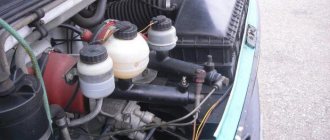Mercedes-Benz Sprinter is a family of German-made commercial vehicles; models have been produced since 1995. The line includes small-tonnage vehicles, including an all-metal van, a flatbed truck, a refrigerated truck, as well as specialized modifications - an ambulance, a manipulator, a crane, a mobile headquarters, etc. In addition, the Sprinter is widely distributed in the form of a passenger bus and a minibus. Maximum passenger capacity – 19+7 seats. Options with automatic transmission and all-wheel drive are available, which can be ordered additionally. Since 2012, the Mercedes-Benz Sprinter has been produced in Russia, in the W901-W905 modification.
Loading capacity of a Mercedes Sprinter van
The Mercedes-Benz Sprinter Classic can cope with any task, whether as a van for transporting goods or as a minibus for transporting passengers. With more than 1.5 million vehicles sold, billions of kilometers traveled and the inherent longevity of the Mercedes-Benz brand, Sprinter has been a proven and reliable partner in the transport business for many years.
Sprinter Classic is focused on what matters most – your work, and therefore your success. Its exceptional reliability, wide range of uses and high efficiency contribute to this. A powerful, durable engine and a sophisticated safety concept are just as convincing as maximum performance and guaranteed maintenance. This is exactly what you can rightfully expect from a Mercedes-Benz van.
Drive unit
In comparison with the Sprinter Classic and Sprinter MRT with 19 seats (for more information about this model, see “Vehicle Fleet” No. 6/2015), the interior of the German Sprinter looks more spacious - due to the increased seat pitch, higher ceiling height (180 mm) and an extended rear overhang. By the way, the abundance of free space behind the rear seats allows you to freely place a couple of heavy suitcases there - it happens that people travel on a minibus with luggage. It’s a pity that there is nothing to secure the load with; hinges are not provided in this configuration.
Second generation
The car has a comfortable interior, there is space for passengers, transportation of luggage and things, the suspension simply floats on the road, corrosion is practically not observed with proper care. The manufacturer offers several options for gasoline engines, characterized by traditional reliability, the ability to operate in any climatic conditions and a long service life.
Driver's cabin
The cabin is made from a sheet of metal, the shape of which is given using a special stamp. The structure includes a hood, and the main components are equipped with elements to increase rigidity. Greater visibility has a positive effect on ease of operation and safety.
The interior of the Mercedes Benz Sprinter 313 CDI accommodates three seats, one of which is intended for the driver, the other two for passengers. Also standard is a seven-seat cabin that can accommodate 6 passengers. The interior decoration is made of modern high-quality materials that are wear-resistant and retain an attractive appearance for a long time. They have soundproofing properties, which reduces the amount of noise when moving. The operator's seat is mounted on springs, it has the ability to adjust the lumbar support and a heating system, and is equipped with a seat belt and a headrest.
The cabin of the 313 is characterized by comfort; in this regard, it is able to compete with passenger cars. The steering column is adjustable for reach and tilt. An additional air conditioner can be installed in the cabin.
To reduce dynamic impacts when driving, the cabin is mounted on a rubber cushion. The controls are carefully laid out to ensure comfort throughout long shifts.
Among utility vehicles, the Mercedes Sprinter, produced since 1995, is extremely popular. This is one of the most common commercial vehicles in the world, with universal technical and operational characteristics that make its use extremely profitable. The main advantage is the fuel consumption rate of all modifications of the Mercedes Sprinter, one of the most economical in its class. The car has other advantages:
- high reliability of all components;
- minimal repair costs;
- high load capacity for its size;
- adapted suspension;
- several options for passenger and cargo bodies with a carrying capacity of up to 4.6 tons;
- ergonomic cabin, adapted for long-distance transportation.
Two generations of this car were presented, the first was produced from 1995 to 2006, the second is still in production. In addition, the model has undergone several restylings in order to improve its appearance and technical characteristics.
Generation 1 (body 901, 1995-2002; 2002-2006 (restyling)) Mercedes-benz gelandewagen
| Fuel consumption per 100 km Mercedes: Gelendvagen, Gl 350, ML 350, ML 400, Sprinter, Vito 2 boosted to 129 horsepower with a torque of 305 Nm and 163 horsepower with a torque of 360 Nm also have identical fuel consumption per hundred, component. speed 158 km h; number of seats in the cabin 3; load capacity 1.44 t; weight 2.07 t; total weight 3.5 t; drive 4x2 or 4x4; wheelbase 3.55 m; turning radius 12.8 m; ground clearance 0.15 m. |
- every 15 thousand km it is necessary to change the brake fluid and oil;
- Once every 2 years it is necessary to clean or replace the air filter, check the wear of the brake pads;
- every 60 thousand km they check the condition of the driveshaft, fuel filter, clutch, change the oil in the automatic transmission.
Mercedes Sprinter owner reviews
If the internal combustion engine has run quite a lot of kilometers, it would not be superfluous to check the axial play of the crankshaft; when driving for a long time with worn axle washers, the cylinder block fails, and then you have to change the engine. Reducing fuel consumption to 8.2 liters per 100 km is achieved by increasing the gap between the extreme gear ratios and the ability to drive at lower speeds.
What affects the fuel consumption of a Mercedes Sprinter per 100 km?
The fuel consumption of this car is not standard and depends on a number of parameters. It is worth considering that there are different modifications of this model with gasoline and diesel engines. Given the different engine technologies and fuel efficiency, consumption will vary greatly between engines requiring different types of fuel. The type of gearbox, drive, vehicle load, and even the driver’s driving style, not to mention the strength of the engine itself, also play a role.
Brake system © Equipment cost
| What is the fuel consumption of the Mercedes Sprinter 2. 7. The second generation Sprinter is distinguished by a well-thought-out driver's position, the small-diameter steering wheel is especially good; it is pleasant to the touch, does not interfere with reading the instruments, the column has settings for the angle of inclination and reach. There are also owners who indicate higher consumption - up to 13-15 liters per hundred, although the average Mercedes fuel consumption per 100 km is around 10-12 liters. |
| Mercedes Sprinter fuel consumption To improve the driving characteristics of the Sprinter, they began to install a 5-speed automatic transmission and a 6-speed manual transmission; later, more modern Tronic Plus automatic transmissions with 7 ranges with rear-wheel drive and all-wheel drive appeared. Ford Tranzit is a German car that is considered the second most popular after the gazelle. It has a slightly larger interior, it can accommodate 17 seats, in addition, many more people will enter it while standing than in a standard domestic mikrik. |
- city mode 15.8 l;
- average consumption 13.3 l;
- on a free highway 10.7 liters.
Features for the North American market
In 2007, a new generation of the Mercedes Sprinter minibus was offered with an exceptionally successful 906 body and an updated line of gasoline and diesel engines with improved dynamics and reduced fuel consumption. Since the guidelines recommend that for vehicles and brands of heaters not listed in them, the calculation of fuel consumption should be carried out according to the manufacturer’s data, I have provided the opportunity to enter my data.
Key features © Mercedes-benz vito
| Consumption of Mercedes Sprinter diesel - Blog of a car lover If in the field Or enter the rate of consumption for the operation of the heater, enter a number other than zero, then it will participate in the calculations, if you leave zero, then the data is from the heater table. According to repeated positive reviews about the car, the fuel consumption of the Mercedes Sprinter per km is 12 liters, because of this, many experienced drivers recommend the German production company. |
| Loading capacity of a Mercedes Sprinter van. Company representatives reported that the Mercedes Sprinter 2018-2019 model year was created by Mercedes specialists without the help of other developers. In cars equipped with a particulate filter, it was initially not used at all, in 2003 it appeared in some models, and later it began to be used en masse and when driving only around the city, problems arise with self-regeneration, and the oil is also diluted by fuel. |
First generation
In the first generation Sprinter, which appeared in 1995, four power units were offered - one gasoline and three diesel. They were paired with a 5-speed manual transmission or a 4-speed automatic.
The only gasoline engine was a 2.3-liter 143 horsepower unit, which accelerated the car to 148 km/h. It is reliable and unpretentious, with fuel consumption:
- city 19.6 l;
- mixed cycle 13.7 l;
- track 10.3 l.
The least powerful was the 2.2 diesel with 82 horsepower, with a torque of 200 Nm, it accelerated the car to 119 km/h, featuring a high level of reliability and good fuel consumption:
- in the city 14.1 l;
- average 10.7 l;
- on the highway 8.7 liters.
Another version of this engine for the Sprinter produces up to 109 horsepower at 208 Nm, accelerating the car to 141 km/h, while it has more economical consumption:
- on a busy street 11.4 l;
- average 8.8 l;
- on the highway 7.4 liters.
The 2.9 diesel engine, installed until 2002, produces 102 horsepower; it is highly reliable, since it was developed for military needs, but is quite noisy. Fuel consumption for this unit:
- in city mode 14.2 l;
- mixed cycle 12.3 l;
- on a free road 9.8 liters.
The most popular option turned out to be a balanced 2.7 diesel with 156 horsepower and a torque of 330 Nm, which accelerates the car to 155 km/h. Its use made it possible to increase the carrying capacity, with adequate fuel consumption:
- in the urban cycle 13.2 l;
- in mixed mode 9.8 l;
- on the highway 7.8 liters.
Is it necessary to comply with fuel and lubricant expense standards from the Ministry of Transport in 2022?
The well-known automaker Mercedes introduced a restyled model of the Sprinter 515 truck to the Russian market. Excellent technical characteristics, functionality, performance and excellent quality - for all this, consumers love these cars. The six-speed manual transmission and fuel-efficient diesel engine allow you to select an economical driving mode. The car's power unit produces a power of 150 horses and complies with the Euro 5 environmental standard. Buying a new Mercedes Sprinter 515 cdi isothermal truck is also worth it for working in harsh climatic conditions, since the truck is designed for cold winters: an additional liquid heater and heated rear-view mirrors are installed, insulated cabin. The car chassis is equipped with an electronic dynamic stabilization system, a front axle stabilizer, an underrun bar, a digital tachograph, a power indicator, a fuel intake for an additional heater, etc.
The fuel consumption of the Mercedes 311 is 8.9 liters per 100 km on average. In the city this figure increases to 11.4 liters, and on the highway it drops to 7.4 liters. The capacity of the fuel tank is 75 liters, and the amount of harmful substances in the exhaust is 300 g/km.
Both modifications of Mercedes minibuses are equipped with a 5-speed manual transmission. There is no automatic transmission even as an option. Nevertheless, this box does not cause any complaints from the owners. This is evidenced by numerous reviews. The transmission can withstand loads well even beyond the norm.
At the front, the car is equipped with an independent suspension (MacPherson strut). There are no coil springs. Instead, there is a single-leaf spring and anti-roll bar. At the rear there is a dependent suspension scheme with a continuous axle. The latter “rests” on leaf springs. The steering system is rack and pinion type (unlike the GAZelle, which uses an archaic gearbox). The hydraulic booster is already included in the basic configuration. The braking system is equipped with various assistants - ABS, EBD and others. Front and rear – disc brakes. By the way, on the front axle they are also ventilated.
Ease of operation and maintenance of Mercedes-benz w140
| Mercedes Sprinter fuel consumption - Blog of a car lover I didn’t like it very much, the engine is rather weak for the Crimean roads, up and down constantly, the engine power is not enough on inclines, especially if the interior is full. St. Petersburg, which occupies second place, lags far behind in terms of cars from the last seven years of production, but can boast of a large number of ancient examples older than 15 years, which the capital is getting rid of more actively. |
| Mercedes Sprinter 312 2.9 diesel consumption. What is the design of the car? Reliable and high-torque diesel engines are more popular. Sprinters equipped with them have reduced fuel consumption, which is a decisive argument for carriers. The manufacturer offers several options for gasoline engines, characterized by traditional reliability, the ability to operate in any climatic conditions and a long service life. |
- Anatoly, Kazan. I have a 2002 Sprinter with a 95-horsepower 2.2 diesel engine. I think that this is the most reliable modification, after 400 thousand km the consumption remains at the level of 12-14 liters depending on the driving mode, on the highway you can reach a consumption of 10 liters. We are pleased with the ergonomic cabin and spacious cargo compartment.
- Dmitry, Vyborg. I purchased a Sprinter with a 3.0 diesel engine in 2010, a cargo-passenger version. I am pleased with the good dynamics, high-torque power of the power unit, practical interior - excellent cargo equipment that solves many problems. The engine pulls well from the very bottom, consumption does not exceed 16 liters even in winter in the city.
- Ivan, Orel. I bought a new Sprinter in 2016 and chose version 2.2 with 163 horsepower. To understand the situation, I’ll say that I switched to it from the old Gazelle, it seemed like I got behind the wheel of a spaceship. Distinguishing sound insulation, dynamics, comfort in the cabin and interior after restyling are only part of the advantages. The average consumption on the computer is 15 liters.
- Sergey, Murmansk. Based on climate realities, for transportation I took the second generation Mercedes Benz Sprinter, released in 2014, with a 3.5-liter gasoline engine with 258 horsepower, all-wheel drive and automatic transmission. I think that for our realities this is the most suitable configuration, with a warm interior and a durable ride. I am serviced at a dealership, so there were no technical problems. Gasoline consumption in the city is 25 liters, which is expected.
Sprinter from 1995 and 2006 • 7 liters for 156 horses in volume more than 313, but at the same time consumption is only 1 liter more on the highway, maximum 12 liters 100 km, if you go 120 km h.
Model range of internal combustion engines Mercedes Sprinter – Cost of new and used
| Consumption of Mercedes Sprinter diesel - Blog of a car lover Since 2011, Mercedes commercial vehicles began to be equipped with a new four-cylinder turbodiesel engine OM651 2143 cm3 in three versions 95 129 163 hp. If we ignore all these minor factors, it is almost absolutely certain that the Mercedes Sprinter never spends excess fuel. |
- diesel four-cylinder OM611 with CDi direct fuel injection in three versions - 82/109/129 hp. With.;
- 2.7 liter CDi diesel (5 cylinders) 156 horsepower, OM models
General malfunctions of 2.1 CDI engines
Mercedes Sprinter is reliability, quality, service and the best choice for any driver. German assembly has long been famous for the best products in the automotive industry, and rest assured that it will not come to repairs if you treat the car with care. If you are a connoisseur of beauty and love the best, then you should definitely have such a car. Know that you won’t find a better minibus than a sprinter.
First generation
In the first generation Sprinter, which appeared in 1995, four power units were offered - one gasoline and three diesel. They were paired with a 5-speed manual transmission or a 4-speed automatic.
The only gasoline engine was a 2.3-liter 143 horsepower unit, which accelerated the car to 148 km/h. It is reliable and unpretentious, with fuel consumption:
- city 19.6 l;
- mixed cycle 13.7 l;
- track 10.3 l.
The least powerful was the 2.2 diesel with 82 horsepower, with a torque of 200 Nm, it accelerated the car to 119 km/h, featuring a high level of reliability and good fuel consumption:
- in the city 14.1 l;
- average 10.7 l;
- on the highway 8.7 liters.
Another version of this engine for the Sprinter produces up to 109 horsepower at 208 Nm, accelerating the car to 141 km/h, while it has more economical consumption:
- on a busy street 11.4 l;
- average 8.8 l;
- on the highway 7.4 liters.
The 2.9 diesel engine, installed until 2002, produces 102 horsepower; it is highly reliable, since it was developed for military needs, but is quite noisy. Fuel consumption for this unit:
- in city mode 14.2 l;
- mixed cycle 12.3 l;
- on a free road 9.8 liters.
The most popular option turned out to be a balanced 2.7 diesel with 156 horsepower and a torque of 330 Nm, which accelerates the car to 155 km/h. Its use made it possible to increase the carrying capacity, with adequate fuel consumption:
- in the urban cycle 13.2 l;
- in mixed mode 9.8 l;
- on the highway 7.8 liters.
Mercedes Sprinter base car
| Specifications |
| Smoothly adjustable heating and ventilation system with 4-stage fan control and two additional fan settings. deflectors to distribute fresh air |
| Easy loading thanks to rear hinged doors with an opening angle of up to 180° |
| Driver's seat with a wide range of adjustments for optimal positioning |
| Steering with rack and pinion mechanism and hydraulic booster |
| Central locking with remote control |
| 16-inch tires size 235/65 R 16 (for the 3.5 t GVW version) |
| Two-way adjustable headrests with fabric upholstery on all seats |
| ADAPTIVE ESP incl. ABS, Traction Control (ASR), Electronic Brakeforce Distribution (EBV) and Brake Assist System (BAS) |
| Adaptive brake lights |
| Airbag (driver) |
| Recoil system for cars with automatic transmission |
| Three-point seat belts in all seats, for the driver's seat and single front passenger seat - with pretensioners and limiters |
| Independent front wheel suspension |
| Burnt out lamp warning system |
| Front suspension stabilizer (for the 3.0 t version - as an option) |
| Adjusting the headlight range |
| Laminated safety windshield |
| Body | Extended | Extra long |
| Wheelbase, mm | 4 325 | 4 325 |
| High roof | ||
| 14,0 | 15,5 | |
| Load capacity (kg) | 1 260 – 2 510 | 1 210 – 2 465 |
| Gross weight (kg) | 3 500 – 5 000 | 3 500 – 5 000 |
| Extra high roof | ||
| Cargo space volume, (m 3) | 15,5 | 17,0 |
| Load capacity (kg) | 1 230 – 2 480 | 1 180 – 2 435 |
| Gross weight (kg) | 3 500 – 5 000 | 3 500 – 5 000 |
| Engines | OM 642 DE30LA | OM 646 DE22LA | M 271 E 18 ML |
| Number of cylinders | 6 | 4 | 4 |
| Cylinder arrangement | V 72° | in-line | in-line |
| Number of valves | 4 | 4 | 4 |
| Working volume (cm 3) | 2.987 | 2.148 | 1.796 |
| Power (kW/hp) at rpm. | 135/184 at 3800 | 65/88 at 3800 | 115/156 at 5000 |
| Rated Torque (Nm) | 400 | 220 | 240 |
| Cargo space volume, (m 3) | 11,5 | 15,5 | |
| Type of fuel | diesel | diesel | super class gasoline |
| Tank capacity (l) | ok 75 | ok 75 | approx 100 |
| Fuel system | microprocessor direct injection system with common rail power supply system, turbocharging and charge air cooling | microprocessor injection | |
| Battery (V/Ah) | 12/ 100 | 12/ 74 | 12/ 74 |
| Generator (V/A) | 14/ 180 | 14/ 90 | 14/ 150 |
| Drive unit | rear 4x2, full 4x4 | rear 4x2 | rear 4x2 |
Fuel consumption
Anyone who does not have a personal vehicle or is trying to save on fuel to travel around the city or between cities is faced with the phenomenon of a minibus. The manufacturer offers several options for gasoline engines, characterized by traditional reliability, the ability to operate in any climatic conditions and a long service life.
Engine
The car is equipped with a power unit of its own production. The OM 651 DE22LA model has a power of 109 kW and a volume of 2.14 liters. It is equipped with 4 cylinders arranged in a row and a high-quality filter to reduce the soot content in the exhaust gas. The last detail improves the quality of the exhaust and allows the engine to be classified as Tier 5/Euro5.
The Sprinter 313 engine runs on diesel fuel. The Common-Rail fuel system supplies fuel at 160 MPa. The rated torque is 305 Nm and the rotation speed is 3800 rpm. At low speeds, smooth injection is ensured, which has a positive effect on the gradual increase in traction force. The injectors have seven holes, which improves the performance of the power plant.
Second generation: Mercedes-benz vito
Due to increasing requirements for the level of comfort, safety, and environmental friendliness, Mercedes cars are acquiring more and more electronic control units. the onboard platform is characterized by increased comfort and spaciousness; three types of wheelbase and platform area of 4.3 m2, 8.7 m2, 9.1 m2;.
| Engine | Consumption (city) | Consumption (highway) | Flow (mixed) | Fuel type |
| 2.8 MT 193 hp (Mechanics) | 15,6 | 8,6 | 11,6 | Petrol |
| 3.0 AT 177 hp (machine) | 13,8 | 8,1 | 10,3 | Diesel |
| 3.2 MT 231 hp (Mechanics) | 14,5 | 9,6 | 11,9 | Petrol |
| 3.2 AT 231 hp (machine) | 19,3 | 10 | 13,4 | |
| 3.5 AT 150 hp (machine) | 11,7 | 7,7 | 9,7 | Diesel |
| 4.2 AT 279 hp (machine) | 16 | 9,7 | 12,5 | Petrol |
| 4.2 AT 286 hp (machine) | 16 | 9,7 | 12,5 | |
| 5.0 AT 320 hp (machine) | 18,2 | 10,8 | 16 | |
| 5.0 AT 326 hp (machine) | 17,2 | 10 | 13 | |
| 6.0 AT 394 hp (machine) | 21 | 11,8 | 16,4 | |
| 6.0 AT 408 hp (machine) | 20,6 | 11,8 | 15,4 |
Restyling 2013 Fuel system
As mentioned earlier, the van received, in addition to everything, a stability control system, a hydraulic power steering wheel and electric windows. The interior lining of the Mercedes Benz Sprinter Classic 311 is made of insulating materials, which guarantees driver comfort when transporting people and goods.
| With medium body length | With extended body length | |
| Car load capacity (t) | 1,315 | 1,435 |
| Body volume (cubic m) | 13,4 | 10,4 |
| Wheelbase (mm) | 3550 | 4025 |
| Loading length (m) | 3,265 | 4,215 |
| Loading area (sq.m) | 5,2 | 7 |
| Operable volume (cubic m) | 10,4 | 13,4 |
| Vehicle weight (t) | 3,5 | 3,5 |
| Weight of van with trailer | 6,3 | 6,3 |
| Load capacity (t) | 1,4 | 1,3 |
| Permissible load weight for towing with/without brakes (kg) | 2800/750 | 2800/750 |
| Turning diameter (m) | 12,8 | 14,3 |
Price for a passenger Mercedes Sprinter Classic. Mercedes-Benz Vito
| What is the fuel consumption of a Mercedes Sprinter minibus. Mercedes Sprinter (Mercedes Sprinter) technical characteristics With proper care, it is highly reliable, and its efficiency makes it one of the best commercial vehicles of our time among minibus-type models. I have been using the van for exactly a year, I decided to sum up the interim results and share my opinion, which may help other people make their choice. |
| Mercedes buses run on diesel fuel. Standard value of fuel consumption. Buses, domestic and CIS countries In 2007, a new generation of the Mercedes Sprinter minibus was offered with an exceptionally successful 906 body and an updated line of gasoline and diesel engines with improved dynamics and reduced fuel consumption. There are four double buttons on the steering wheel, with which you control the on-board computer, radio volume, telephone, and Assyst maintenance system. |
- on city streets 8.9 l;
- on average 7.4 l;
- on the highway 6.6 liters.
How is it operated and maintained?
To operate the automatic system, a video camera is used, located above the front window of the Mercedes Benz Sprinter Classic. It transmits a signal to the on-board computer, which turns the lighting on and off. ABS and ASR provide traction in difficult conditions, while a reliable braking system and passive safety systems guarantee protection in dangerous situations.










